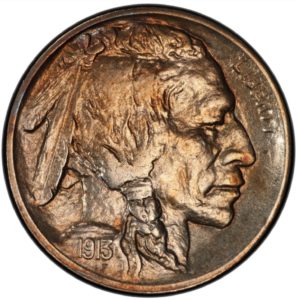Buffalo Nickel (1913-1938)
During Theodore Roosevelt’s presidency, five US coins received new designs. He left office in 1909, but the desire to produce more inspiring coin designs was still alive. That was made further possible with the Coinage Act of 1890 that allowed designs to be changed after 25 years. The particular coin up for a redesign was the Liberty Head Nickel in production since 1883.
Sculptor James Earle Fraser was chosen to work on the new design. He settled on using a portrait of a Native American on the obverse and an American bison on the reverse. The coin became known as the Buffalo Nickel and was made from 1913 to 1938, when it was replaced by the Jefferson Nickel still used to this day.
History of the Buffalo Nickel
James Earle Fraser was an assistant to the famed Augustus Saint-Gaudens. He was also a well-regarded artist in his own right, with the “End of the Trail” Indian sculpture being one of his best works. His portrait on the obverse of the new five-cent piece is the most accurate depiction of a Native American in coinage.
In the past, the busts were clearly Caucasian but with an Indian headdress. Native American chiefs have sat for Fraser before, and the portrait in the new five-cent coin was a composite of three chiefs. Accompanying the portrait on the obverse are the date and the word LIBERTY.
The reverse of the Buffalo Nickel features an American bison, along with the words UNITED STATES OF AMERICA and E PLURIBUS UNUM. The former is presented in much bigger type than the latter. Below the bison is the value of the coin in word form: FIVE CENTS.
Treasury Secretary Franklin MacVeagh liked the design, but there were reservations from other parties. The Hobbs Manufacturing Company, for example, asked for changes to be made because the coin would not work on their machine. Rather than give in, MacVeagh instructed the Mint to go on with the production, letting machine vending companies like Hobbs adjust to the new design.
Collecting the Buffalo Nickel
The Philadelphia, San Francisco, and Denver mints made Buffalo Nickels from 1913 to 1938. More than 1.2 billion were made at the three mints, with mintmarks found on the coin’s reverse. The initial (F) of the designer is also found below the date.
Buffalo Nickel coins come in two varieties: Type 1 and Type 2.
Type 1 Buffalo Nickel pieces were minted in the first few months of 1913. The words FIVE CENTS are presented on a raised mount, but rapid wear prompted a design change. Chief Engraver Charles Barber, who was overlooked for the design of this coin, set out to make changes and those became the Type 2 Buffalo Nickel.
Although Barber made changes throughout the coin’s run, he was never able to address the wearing of the date. Instead, his changes involved smoothing the details, with the last changes made in 1916.
The years 1922, 1932, and 1933 saw no Buffalo Nickels made. From 1913 to 1916, over 5,000 Buffalo Nickel matte proofs were made. Also, more than 10,000 brilliant proofs were made in 1936 and 1937.
When the Buffalo Nickel reached the end of its run, it was replaced by the Jefferson Nickel which continues to be the design to this day.
